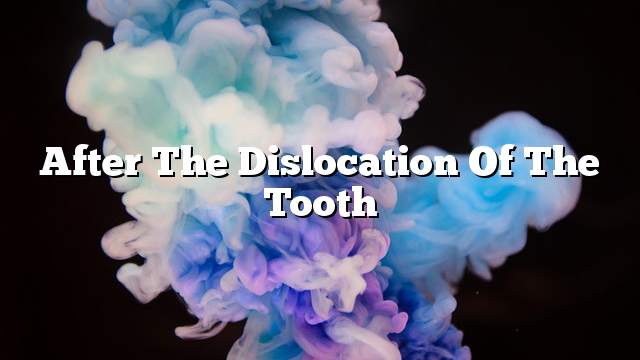Tooth extraction
Dislocation of the tooth means the removal of the tooth for some reason, and since the teeth are important in terms of aesthetics and functional, all efforts are made in order to maintain and avoid taking off, but there are some cases that require the removal of the end. The general anesthesia (General Anasthesia) is used in cases of implanted teeth or if more than one tooth is removed. There are many ways to remove the tooth depending on its position. In the case of dental implants may resort to the work of cutting in the gums to facilitate the process of removing the tooth, and sometimes the separation of the tooth to several parts to be easily removed, and after the dislocation of a piece of gauze is placed in the wound to cut the bleeding, the doctor may need sometimes to sew the wound, It is worth mentioning that the work Dental removal is performed by a dentist or an oral surgeon. The recovery and recovery period takes about two weeks during which the bone and the tissue grow to fill the opening resulting from the tooth extraction.
After the dislocation of the tooth
The patient must adhere to a number of things that reduce the sense of discomfort, and also reduce the risk of infection, and it helps to accelerate recovery, and these instructions and procedures include:
- Commitment to pain relievers administered by the doctor, as well as those that are administered over-the-counter.
- Pressure on the piece of gauze that the doctor places the place of dislocation by biting it; to stop hemorrhage, and to allow blood clot to form the place of dislocation.
- Put a bag of ice on the affected area to relieve swelling, where the snow is placed for ten minutes at a time, with the need to ask the doctor about the number of times necessary.
- Take a rest with relaxation during the first 24 hours after the toothpaste, while trying to minimize activities in the next two days of the castle.
- Refrain from spitting and rinsing during the first six hours of tooth extraction to avoid the loss of blood clot forming at the site of extraction. After that, it is possible for the patient to be rinsed with a salt solution consisting of a cup of warm water and half a teaspoon of salt.
- Drinking is prohibited by straw during the first twenty-four hours of mastication.
- Smoking is prohibited because it has an effect on the delay of healing and healing time and discourage them.
- It is recommended to eat soft foods such as yogurt in the day following dislocation, and then solid food is added gradually until the patient is fully recovered.
- Raise the head on the pillow when lying down; lying in the normal position without raising the head may lead to an increase in the duration of hemorrhage.
- Continue brushing teeth and cleaning them with medical dental thread, taking into account the move away from the place of extraction, and cleaning will reduce the chances of infection.
Check with your doctor
After removal of the tooth, it is normal for the person to feel some pain, especially after the end of the effect of anesthesia, and also expected to be a slight swelling and bleeding during the first twenty-four hours of the time of dislocation, but you should contact the dentist and review in the following cases:
- Bleeding continued for more than four hours of dislocation of the tooth.
- Feeling very painful.
- Signs of inflammation, such as fever and chills.
- Redness of the place of extraction, or swelling, or the appearance of a substance leaked from it.
- Vomiting or nausea.
- Feeling chest pain.
- Cough and shortness of breath.
Causes of dislocation of the tooth
There are some cases where dislocation is the best solution, including the following:
- Tooth decay can not be repaired. Dental caries may extend to the heart, causing inflammation of the pulp of the teeth. If the inflammation does not respond to antibiotics, age is the best option to reduce the spread of inflammation.
- Many of the cases that have not been treated properly, such as Severe Periodontitis or tooth abscess, require dental treatment through the Root Canal Treatment, If the patient does not undergo the necessary treatment, it may be necessary to remove the tooth.
- The dentist usually removes the tooth to prepare the mouth for the orthodontic process. The aim of the orthodontist is to arrange it correctly in the mouth. The teeth can not be repaired if there are large teeth that do not fit the size of the teeth. Mouth, or in the absence of some of the emergence of teeth because of the lack of a place, and thus become the best solution for oral preparation of the process of orthodontics.
There are some other cases that may require dislocation, including:
- Soft tissue in the cheek is damaged by the presence of bad or inappropriate teeth.
- Teeth fractured by exposure to accidents and blows.
- Extra teeth in the mouth are normal.
- The tooth on the fracture line in the jaw.
- Teeth adjacent to the pathogenic lesions that have been planned to be removed.
- Radiation therapy involves preventive extraction of teeth.
- Some aesthetic considerations, such as having an abnormal internal color or a bad color.
- Some economic considerations, such as the patient does not have the price of treatment and then forced to uproot the tooth.
